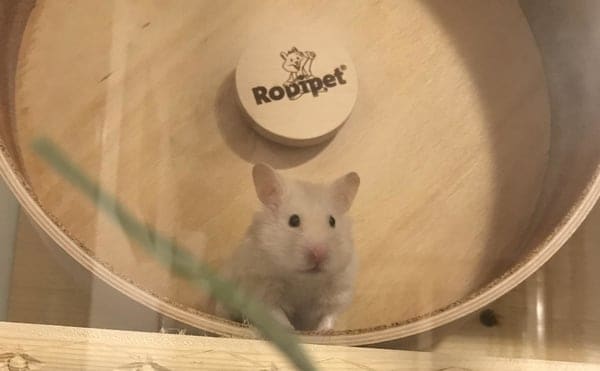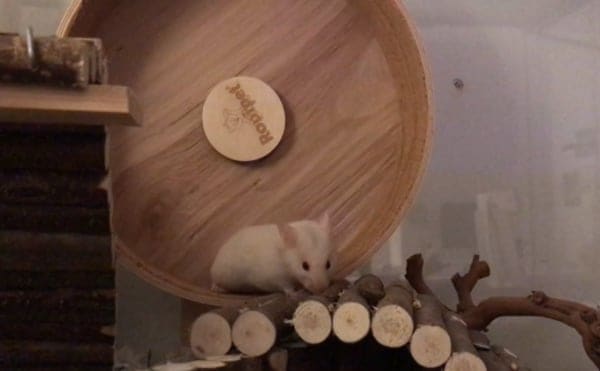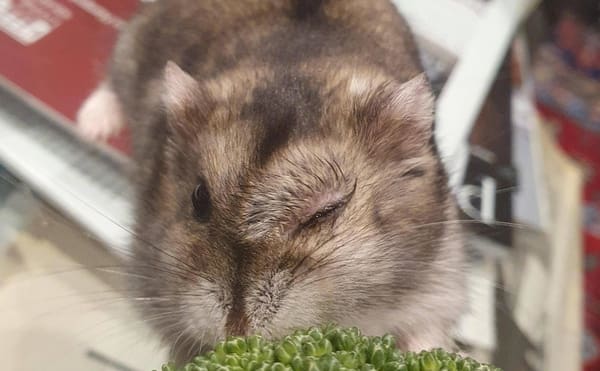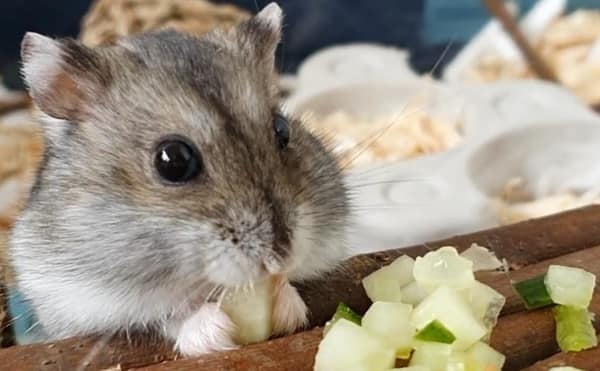Hamsters can be great companions in our homes, and those lucky enough to share a roof with one treasure their time with these pocket-sized pets. However, when something seems wrong or off with our furry friends, it can often cause us to worry, especially when it comes to a hamster’s prized running wheel.
So, why is my hamster not running on his wheel? If your companion used to be a fan of its exercise wheel but has recently slowed down, the most likely answer is that your hamster is aging.
This article will examine age, illness, and injuries that might prevent your pal from running on its wheel. Additionally, this article will discuss wheel design, hamster personality preferences, and nutrition.

Hamster Golden Years
Hamsters make for wonderful companions, but unfortunately, they are somewhat short-lived in comparison with other domestic animals. Depending upon the breed, most hamsters get to spend between two to three years with their humans.
This means that by the time our furry friends get to be about a year and half old, they are nearing “over the hill” status and likely will begin displaying signs of aging, many of which are quite like those that we display: thinning hair, arthritis, and even vision and dental changes.
One of the earliest signs that your pal is getting on in years is a noticeable decrease in activity, so if your hamster is 18 months or older and has recently stopped using its wheel, age may be the reason.
As your hamster ages, it likely will stop running in its wheel or through tubes as much, it may spend more time in its hide or wake later in the day than usual. Additionally, your furry friend may not be showing as much interest in its former favorite foods or treats, or could begin to develop cataracts (a cloudy, milky area in the eye).
If you start noticing these symptoms in your companion, the best thing to do is help make the environment more comfortable. If you have a multi-level enclosure, consider changing to a single level for safety and ease of mobility.
Make sure food and water as well as toys your pal still enjoys are easily accessible and be extra rigorous about maintaining cleanliness in the enclosure.
Further, if you notice your aging hamster’s teeth are crooked, brittle, or broken, you will need to adjust its diet to softer foods such as hard-boiled egg, cucumber, or pellets soaked in water. Making these changes will help keep your companion comfortable, healthy, and likely will extend its life with you.
If your hamster is still young and has recently stopped using its wheel, it may be ill or suffering from an injury.
Illness or Injury
If your hamster still has its youthful glow but suddenly stopped using its wheel, especially if it was an avid runner before, you should try to eliminate the possibility of illness or injury as soon as possible.
Being of such small stature, even mild illness or injury can turn serious quite quickly for hamsters. Common ailments to watch out for in hamsters include respiratory infections, digestive problems, abscesses, fleas or lice, and ear infections. Some of the most common signs and symptoms of conditions like these are below:
- Decreased appetite
- Decreased activity
- Huddling or hunching
- Dull, ruffled coat or hair loss
- Sneezing, wheezing, or discharge from nose and/or eyes
- Wetness around the tail
- Diarrhea
- Lumps under the skin
- Circling (walking or twirling in circles)
This list is not all-inclusive, but everyone who shares their home with a hamster should be able to recognize these signs and get to the veterinarian right away for preventative care.
Aside from illness, your former track star could be suffering from an injury. Hamsters are extreme busy bodies and are almost always moving in one way or another. Unfortunately, being nocturnal, much of this activity and any subsequent injuries take place at night or early morning.
If your young, healthy friend stopped using its wheel suddenly, examine it closely for cuts, scrapes, or other abrasions. Additionally, look for swelling and listen for popping or cracking when your hamster moves, as this could indicate a fracture.
The best course of action if you suspect a fracture is to schedule a visit to your veterinarian as soon as possible for a diagnosis and treatment. Even though it is difficult to treat a broken bone in hamsters due to their size, they tend to heal quite quickly and can come back from an injury in little time, allowing them to go back to their entertaining antics.
If you have a young hamster who is healthy and all in one piece, but it still has started showing disinterest in its wheel, it could be the wheel itself that is the problem.

Wheel of Fortune
Hamster wheels seem like a straightforward addition to any good hamster enclosure, and it would make sense that all wheels sold in stores or advertised for our furry friends would be equally safe and ideal for them. Sadly, however, that is not always the case.
Wire wheels can be quite dangerous for our furry friend’s tiny feet, as the slats are often wide enough to fall through and cause injury to feet and legs. If you have a wire wheel, your hamster may have injured itself on it and is now avoiding the wheel entirely.
Consider replacing it with a higher-quality, smooth-surfaced wheel made of plastic or smooth wood. These materials make them light enough for the hamster to push easily and provide a safe, comfortable surface with enough grip to make running enjoyable for your pet.
In terms of a wheel for your pocket-sized pal, size matters! Some breeds only need small wheels, while others like the popular Syrian hamster, require a larger wheel. Dwarf breeds like Roborovski hamsters require a minimum circumference of six inches, while their larger cousins should have eight inches at the very least, with ten being ideal.
When your hamster runs on its wheel, its back should be as straight as possible—if the wheel is too small, its back will arch which could cause pain and long-term health problems. Conversely, if a wheel is too big, especially for dwarf breeds, it could prove too bulky for the hamster to push causing disinterest at best, exhaustion at worst.
If your friend has suddenly stopped using its wheel and is otherwise happy and healthy, double-check that your wheel is sized properly to your pal and get a new one if need be. Your companion will thank you!
Age aside, if your hamster has the proper wheel and is not showing any signs of illness, double-check your pal’s diet to make sure it is balanced.
Proper Nutrition
Hamsters expend a great deal of energy every day being such busy bodies, and therefore need a balanced diet. Hamsters are omnivorous, meaning they eat both plants and animals, so they need some basic fats and proteins in their diets as well as the typical roughage.
The ideal diet for a homebound hamster includes plenty of grass hay like timothy, hamster pellet or pellet mix with seeds, fresh vegetables, the occasional fruit, mealworms and/or egg for protein, and of course access to fresh water always.
You may already be giving your hamster these things (and if you are not, it is okay, just start now!), but it still could be suffering from a lack of balance in its diet. Without proper nutrition, your friend may become lethargic or sluggish, possibly explaining its sudden disinterest in running.
Outside of being fed improperly, this could be the result of your hamster being picky. Like us and any other animal, hamsters have food preferences, and when they hoard and create stashes, they may only be keeping the good stuff. Observe your pal while it eats or stores food to see what the imbalance may be and correct for the missing nutrients using other food sources.
If you have read this far and nothing sounds quite right, it’s possible that your hamster simply may be tired of its wheel, or conversely, has not stopped using the wheel at all!
Lazy, or a Night Owl?
Most animals have their own unique personalities and preferences, and hamsters are no different. Your pal may have enjoyed its wheel for quite some time but woke up one morning and decided running just was not its thing anymore. Further, your hamster may simply be a little lazy compared to its friends, which is normal.
If it is getting exercise in other forms like a hamster ball, climbing levels, or a burrowing box, it should be just fine. Contrarily, your hamster may in fact be using its wheel all the time—just not when you are watching.
Hamsters are natural night owls, and much of their activity takes place in the late evening, night, or wee hours of the morning when you may not be awake. If your hamster inhabits another room or you have a particularly quiet wheel, you may not be hearing your friend when it is running its nightly marathons.
Mark the top of your wheel or sprinkle a little bedding on top before you turn in for the night to see if it has moved the next morning. If your hamster simply prefers not to have an audience, there is no need to worry.
Conclusion
If your hamster previously loved running in its wheel but seems to have slowed down lately, there is a good chance it is because your companion is approaching its golden years, in which case you should make some changes for your pal’s comfort.
Your hamster may be suffering from an illness or injury, so observe them closely and get them to a veterinarian as soon as possible. Further, make sure your furry friend’s wheel is of the correct material and size for its safety and comfort, as it may be avoiding the wheel due to pain.
You should also check to make sure your hamster is getting balanced nutrition, lest it become lethargic or ill. Finally, determine whether your hamster has actually stopped using its wheel at all, given its nocturnal nature, and observe your hamster to figure out its personality, as it may simply not want to run in anymore, which is okay too.
If your companion is happy, healthy, and comfortable, try not to worry too much and enjoy your time together.



